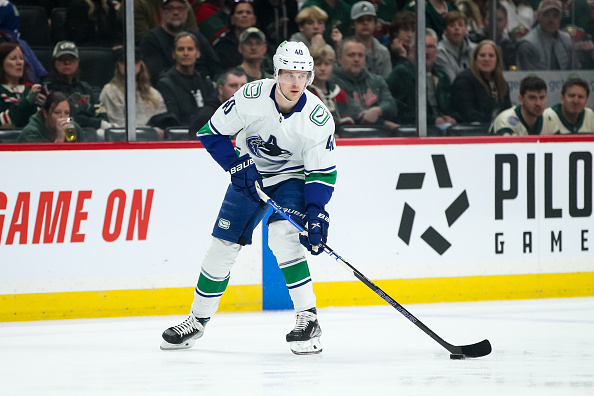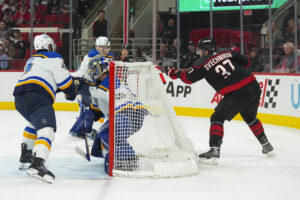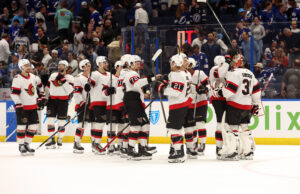“Superstar Elias Pettersson” is a descriptor that’s been dragged out for the Vancouver Canucks top centre since he entered the league. It hasn’t been a comfortable fit.
Elias Pettersson’s Starring Role
With the top of the 2017 draft taken by the “Nico vs. Nolan” debate, and the two best defencemen already gone, the Canucks selection was obvious. At fifth overall, they would pick up the top-line centre the team desperately needed. With Hischier and Partick guaranteed gone, there were only, uh, five other choices. Okay, so it wasn’t that obvious.
Still, Cody Glass seemed like the obvious pick. At 6’2″ and 180 lbs, his physique was close. He’d scored 32 goals and 94 points for Portland in the Dub. Smart guy with a strong two-way game, too. Or, if not Glass, then Casey Mittelstadt. Excellent skater, tipped the scales at 200 lbs already. Totally dominant in the USHL. Or, if they wanted to go off the board a bit, Surry-born Michael Rasmussen was racking up goals for Tri-City with 32 in just 50 games. A pretty substantial 6’5″ too. Or the skilled grinder Gabe Vilardi, who doesn’t just put up points but gets involved in all three zones.
You get the point. When Pettersson’s name was called, a “Wait. What?” moment among the fans.
Patience, Patience
Don’t get us wrong: Pettersson was ranked as a top-10 prospect on most lists. Just a lot closer to 10 than Vancouver’s slot. He’d done really well in the Allsvenskan, and decently internationally. But he was also getting used on the wing and weighed a sopping-wet 160 lbs. Those aren’t exactly the shoulders you put a franchise on. Even he said he wasn’t ready for the NHL.
Pettersson on not signing a contract : "I'm not ready for the NHL, a contract is not what I need at this point." #Canucks
— Rick Dhaliwal (@DhaliwalSports) August 3, 2017
Still, hey, plenty of skill there, and he was moving up a league next year. We’ll see what happens.
The next year, playing in the Swedish Hockey League, he led his team in scoring. By 15 points. Then led them again in the playoffs with 10 goals and 19 points in 13 playoff games. Concerns about his ability to handle bigger, older players diminished after that. Obviously, he wasn’t going to pull off that level of scoring in the NHL as a rookie. Especially not on a team that hadn’t been within spitting distance of “NHL .500” for three years. New, league, new continent. A year in the AHL while he bulks up a little first would make sense.
That made sense, too, until Pettersson made camp.
“Superstar Elias Pettersson!”
It ends up when you win a pile of trophies in the SHL, it means you’re a pretty good player. His rookie season in Vancouver ended with him leading the team in both goals (28) and points (66). He couldn’t drag them into the playoffs, but they finished one game below NHL .500, which was a nice change. They did make it next year, and while Pettersson couldn’t improve on his regular-season numbers (27 goals and 66 points), he did lead the team in playoff scoring.
Which is great! A point-per-game pace is fantastic for a player breaking into the league, and likewise one in his first playoffs. Some marvellous highlight-reel scoring efforts were combined with beautiful, seeing-eye passes from the past two years. But, ah, we said “superstar Elias Pettersson” y’know?
He had injury problems in Year Three, limited to just 26 games. Realistically, 10 goals are fine. That projects out to 30 over a full season and his 21 points to, ah, just under 66. Again. Hm. Maybe if he actually played a full 82-game season, he could show what he can really do!
Putting on a Show
And so this season he finally has. He played 80 games for the first time in four years, broke the 30-goal mark, and ended with… 68 points. That, with a new three-year, $22 million contract. Which ends with him being paid $10,250,000 in his final year, and what a qualifying offer must be based on. And you thought the Brock Boeser contract was a tricky one.
The reason for the tilted deal is obvious: it gives team ownership time to recover from the recent pandemic-inspired depression. There are a LOT of tourism dollars in the Aquilini family’s fortune, and that took a considerable hit. There’s a lot of pressure not only on Pettersson to live up to that third season mark but on general manager Patrik Allvin to get full value from him. Two more years of sub-70 points and there are going to be some hard questions come March 2024.
It’s not like he can’t reach those highs. This year had a very slow start between the distraction of contract negotiations and recovering from injury. That sluggishness continued through the coaching and management changes: he scored just 11 goals and 24 points in his first 45 games. New coach Bruce Boudreau moved him up and down the lineup trying to find a combination that worked for him. Last year’s J.T. Miller – Pettersson – Boeser line just didn’t have the same magic this season.
Out of NES-essity
One that did last year only played 14 games together, for obvious reasons. But when Nils Höglander and Vasili Podkolzin joined Pettersson, they were dynamite. The three have relentless engines and enough skill to find the puck and do something with it. Podkolzin’s best feature is that he takes it as a deep, personal affront whenever the opposing team has the puck. Hoglander had some horrible luck with linemates finishing his plays but still managed a 53.4% Corsi at even strength. And Pettersson is Pettersson.
The trio had an expected goals of 69.6% in those 14 games. Their expected goals for per 60 minutes of play was 4.5 and against was 2. Any time you can expect to score more than twice as often as your opponents you’re having a good game.
For those of us Old Folks who remember the Nintendo Entertainment System Ice Hockey game, players could choose one of three characters. The small guy was quick and skilled, the big guy strong and slow, the average was… you know. While Höglander is 5’9″ he isn’t exactly “small” – try kicking a fireplug down the street and see how small it is. Podkolzin is only slow if you compare him to some of the true speedsters out there, and his hands are plenty quick. And while he might not be “superstar Elias Pettersson” right now, no one is describing him as average.
Keeping Good Company For Elias Pettersson
But it is a combination that works. For a team with an uncertain future, having a successful line composed of three of the youngest players on the team is an automatic win. Amusingly enough, Pettersson’s second-best combination was with Podkolzin and Conor Garland, so the line name still works. That may be an easier option for the coach, given Garland’s experience over Höglander’s.
The big question is whether that’s the best use of Pettersson’s ice time. There will be justifiable hesitation about how many minutes Pettersson gets – and who gets them with him. Whether he’s the most skilled skater on the team right now – hard to argue when there’s a 99-point winger next door – and if he will be matters. The Canucks need him to live up to his billing in the next two seasons. Should Miller get traded away, a lot more pressure is on Pettersson to perform.
Elias Pettersson is currently a star in the NHL. He has the highlight reel to prove it. For the Vancouver Canucks to take their next step forward, he’ll have to be Super.
Main Photo:






